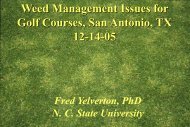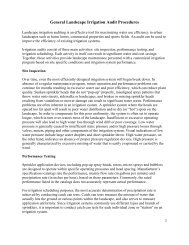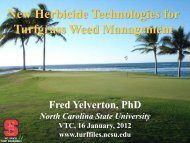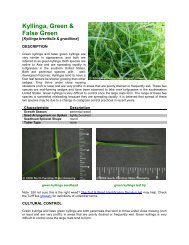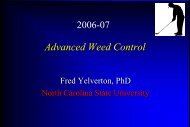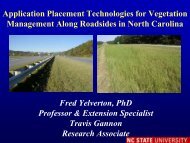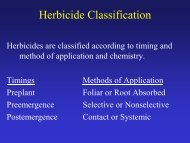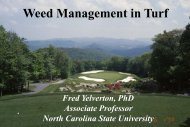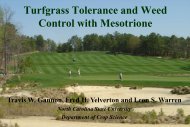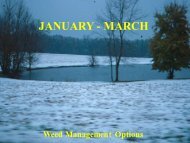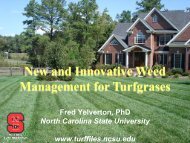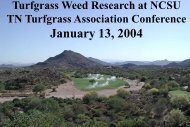Carolina Athletic Fields: - TurfFiles - North Carolina State University
Carolina Athletic Fields: - TurfFiles - North Carolina State University
Carolina Athletic Fields: - TurfFiles - North Carolina State University
- No tags were found...
You also want an ePaper? Increase the reach of your titles
YUMPU automatically turns print PDFs into web optimized ePapers that Google loves.
<strong>Carolina</strong> <strong>Athletic</strong> <strong>Fields</strong>: A Guide to Maintaining Quality Turf on <strong>Athletic</strong> <strong>Fields</strong>Table 1. Field dimensions and sizes of various sports fields.Sport Dimensions (Feet) Area General CommentsFootball360L by 160W57,600 square feet (or1.3 acres)This 1.3 acres is within the sidelines. Outside the sidelines is typically 20or more feet or 30,000 square feet of space. Together these two areascomprise approximately 2 acres. Primary play is between the hash markswhich comprise about 20,000 square feet.Baseball90 betweenbases110,00 square feet (or2.5 acres total) withapproximately 11,500square feet of skinnedinfieldBaseball fields vary in size depending on the depth of the fences (300feet minimum fair line to 400 feet to center). A minimum of 12 feet inthe outfield and 8 feet around the stands is used for the warning track.Professional fields are usually 15 feet in the outfield and 12 to 15 feet infoul territory. The infield receives heaviest play. (Note: Little League, PonyLeague, and Babe Ruth League have smaller dimensions than listed). Seepublication AG-725 Baseball Field Layout & Construction.Soccer360L by 225W81,000 square feet (or1.9 acres)Soccer fields contain an average of 78,000 square feet with an additionalarea of 8,000 to 10,000 square feet along the sidelines, which receiveheavy traffic. A soccer field is larger than a football field, mostly in width,but soccer has many dimensions, depending on the age of the participants.Goal mouths, center field, referee sidelines, and the four cornerkick areas have highest wear.Softball65 betweenbases40,000 to 70,000square feetSlow pitch softball has an average fence depth of 300 feet and approximately70,000 square feet of turf, depending on the sideline areas. Fastpitch softball fields have an average depth of 200 feet and approximately40,000 square feet of turf, depending on the sideline area. The 3 outfielderpositions have most of the turf wear.What to PlantIt is best to consult with a state turf specialist or anestablished field construction contractor to discuss grassoptions. No one type of grass is best suited to all situations.A number of factors should be considered beforedeciding which grass to plant. Your decision should bebased on region, climate, intended use or wear at the site,and desired appearance. For the most part, NC fieldsare grassed with a bermudagrass. There are some exceptionsin the mountains, but even in much of western NC,bermudagrass is often used on fields.Bermudagrass is desirable for athletic fields becauseit establishes quickly, withstands wear and traffic, andrecovers rapidly from injury. Bermudagrass is extremelydrought tolerant, grows rapidly on most soil types, andmakes a good turf surface if fertilized and mowed lowand often. Cultivar texture ranges from coarse to fine,and it forms a dense, durable surface when grown in fullsunlight.Most finely textured, high-quality turf-type bermudagrassesare planted using sod, sprigs, or plugs. Commonbermudagrass, which is the most coarsely textured, can beseeded. Several newer cultivars that have a medium texturecan also be seeded. Bermudagrass should be seeded at 1 to2 pounds per 1,000 square feet (45 to 90 pounds per acre).Currently, the best and most often used hybrid bermudagrassfor sports fields is Tifway (also called Tifton419). Other improved bermudagrasses sometimes foundon athletic fields include TifSport, Patriot, Celebration,GN-1, and Tifton 10. These grasses must be establishedvegetatively, most commonly by sprigs and less so byplugs or sod. The initial cost of these planting methodsis greater than seeding common bermudagrass; however,for the desired aesthetics, color, density, texture,and recuperative potential, these improved cultivars aresuperior to common bermudagrass.Seeded bermudagrasses (common bermudagrass) areused primarily because they can be established by seed,which is relatively inexpensive. However, one shouldrecognize that compared to Tifway bermudagrass, mostseeded bermudagrasses produce a lower quality surfacedue to their lighter green color, coarser leaf blades anddensity, unsightly stem and seedhead production duringsummer, and slower recuperative potential. Princess 77and Riviera are two cultivars that can be seeded and areof high quality, similar to the best vegetatively establishedcultivars. Riviera is also known for its excellent cold tolerance,as is the coarser textured Yukon.Other improved common bermudagrasses that havebetter color and density compared to the old Arizona4



